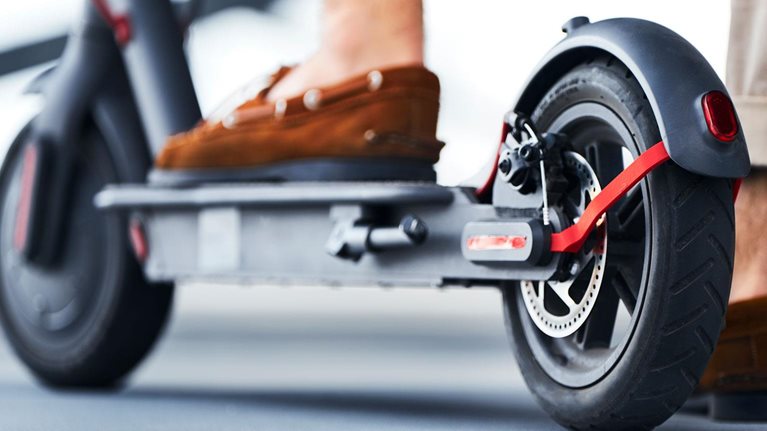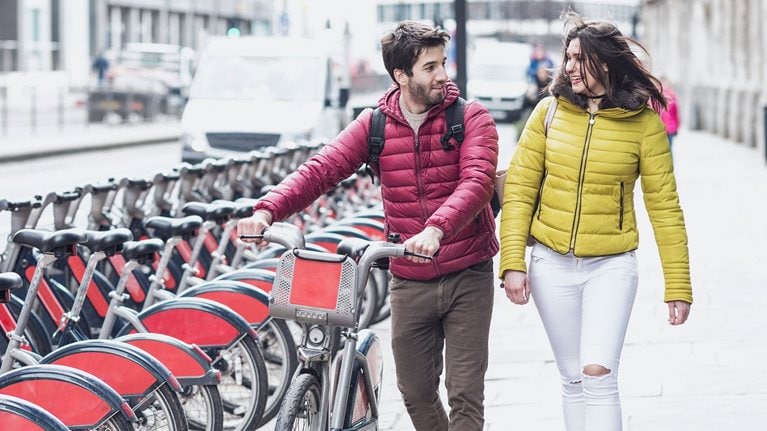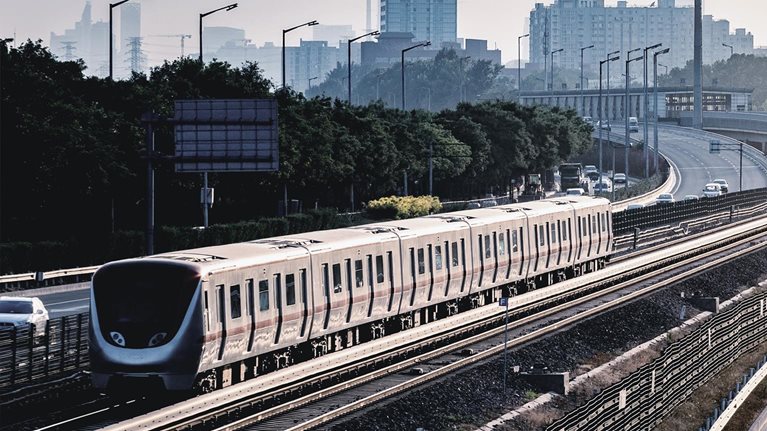The COVID-19 pandemic has affected millions of people worldwide, bankrupted businesses, and plunged the global economy into crisis. While lockdown measures and shelter-at-home orders are helping contain the coronavirus, they have also brought severe financial hardship. Amid a new reality of working from home, canceling trips, and even forgoing outings to restaurants and grocery stores, the micromobility industry—encompassing a range of lightweight vehicles such as bicycles, e-scooters, and mopeds—is facing devastating declines in ridership and revenue.
The blow to micromobility came just as the industry was accelerating. In 2019, a banner year, our models predicted that the micromobility industry would be a $300 billion to $500 billion market by 2030. Our benchmark assessment of micromobility’s potential impact on the city of Munich also suggested good things ahead. Then, the pandemic hit. With the number of passenger-kilometers traveled declining 50 to 60 percent worldwide since the onset of the COVID-19 crisis, use of micromobility solutions has declined dramatically. To determine the full impact of the pandemic on this sector, as well as on future developments, we examined micromobility over three time horizons (Exhibit 1):
- Short term. What effect is the global lockdown having on micromobility now?
- Medium term. Will we see a complete recovery, and what will the next normal look like?
- Long term. What effects will the pandemic have on our 2030 market modeling?

This article is part of a series on the future of mobility after the COVID-19 crisis.1
Short term: Spiked valuations and more bicycle lanes
In our short-term analysis, we examined the impact of the global pandemic on micromobility by examining the response of the industry itself, consumers, and cities.
Micromobility-service providers are struggling
The global lockdown is profoundly affecting service-provider valuations, workers employed in the sector, and the speed of industry consolidation. For example, the valuation of one company operating a worldwide network of e-bikes and e-scooters recently dropped by a reported 79 percent. Another provider halted operations in six US cities and all of its European markets, laying off 30 percent of its workforce. A third company cut working hours for 60 percent of its staff while supplying a streamlined fleet of its e-scooters to healthcare workers in Germany. The lockdown has also accelerated industry-consolidation moves. For example, a micromobility company recently acquired the e-bicycle and e-scooter business of a major ride-hailing company.
Consumer behavior is shifting rapidly
In response to measures to control the COVID-19 pandemic, such as shelter-at-home orders, local travel preferences are quickly changing. One example is the preference for longer trips. According to a US micromobility company that rents e-scooters, average trip distances have grown 26 percent since the start of the pandemic, with rides in some cities, such as Detroit, increasing by up to 60 percent. At a more detailed level, some cities are also experiencing a shift in consumer use cases. For instance, in San Francisco, the lockdown has caused a pronounced shift toward runs to the pharmacy and trips to restaurants to pick up food.
Cities are offering greater support for biking
Worldwide, the lockdown has driven new citywide policies. One major result is an increased focus on bicycle lanes. Consider the following:
- Milan has announced that 35 kilometers of streets previously used by cars will be transitioned to walking and cycling lanes after the lockdown is lifted.
- Paris will convert 50 kilometers of lanes usually reserved for cars to bicycle lanes. It also plans to invest $325 million to update its bicycle network.
- Brussels is turning 40 kilometers of car lanes into cycle paths.
- Seattle permanently closed 30 kilometers of streets to most vehicles, providing more space for people to walk and bike following the lockdown.
- Montreal announced the creation of more than 320 kilometers of new pedestrian and bicycle paths across the city.
Would you like to learn more about the McKinsey Center for Future Mobility?
Midterm: Recovery and the next normal
As the pandemic wanes in some locations, it is natural to wonder when people will start to travel again. Based on an analysis of Apple iPhone data, the number of passenger-kilometers traveled by private and shared micromobility vehicles has decreased by an estimated 60 to 70 percent in Europe and the United States. Interestingly, the same data source already shows a U-shape recovery; extrapolating this trend indicates a recovery to precrisis levels of travel by 2021–22.
To determine if and when micromobility would recover, we conducted a global consumer survey in May 2020. It included more than 7,000 respondents from seven global markets—China, France, Germany, Italy, Japan, the United Kingdom, and the United States. Our goal was to investigate consumer mobility behaviors and expectations before, during, and after the crisis.
According to our consumer survey, the use of micromobility might increase. It showed that the number of respondents willing to use micromobility in the next normal on a regular basis will increase by 9 percent for private micromobility and by 12 percent for shared micromobility compared to precrisis levels. Given these trends, we believe that private- and shared-micromobility solutions will experience a complete recovery in the number of passenger-kilometers traveled, with no significant drop from precrisis levels. We also believe that mobility in general will fully return to precrisis levels.
Some consumer priorities and usage patterns are changing
While the industry itself will persevere, micromobility will undoubtedly look different after the crisis as it enters the next normal. Take consumer behavior, for instance. Prior to the pandemic, our consumer surveys revealed that the main pain point felt by regular users of shared micromobility was the time to destination. Now, it is the risk of infection (Exhibit 2).

When asked in our May 2020 survey about measures that would increase the consumer likelihood of using shared-micromobility services, 47 percent of respondents cited regular disinfection of equipment, 43 percent said physical distancing from the previous or next user, and 31 percent said user-health checks.
While consumer concerns are changing, ridership preferences by age will likely remain static. In private micromobility, we expect to see a similar split across all age groups, precrisis and postcrisis (Exhibit 3). Currently, about half of all shared-micromobility users are younger than 34, with the fewest users older than 55. Based on our consumer surveys, we do not anticipate a change of this ratio in the postpandemic era.

Mobility patterns will likely change
As seen during the COVID-19 crisis, average trip distances might increase, since people will use micromobility solutions more often when commuting. In our 2019 global ACES2 consumer survey, less than 20 percent of all shared-micromobility trips typically involved commuting. However, this survey also indicated that more than 70 percent of respondents would consider buying a private e-scooter for everyday commutes to work or school. This shift could boost private ownership in the e-scooter market.
Industry consolidation will continue to accelerate
With drastic decreases in ridership and revenue, shared-micromobility providers find themselves in a more precarious position—and this could continue the accelerated consolidation of companies. In turn, greater acceleration could improve the business case for micromobility providers and increase profitability, given the synergies and scale-efficiency improvements that occur when buying larger volumes of vehicles, processing more payment transactions, and capturing greater back-office scale effects, along with a higher number of insurance fees. Furthermore, cities may reduce their permit fees to support micromobility as an alternative to private-car ownership after the COVID-19 crisis. For example, our analysis shows that the profitability of shared e-scooters could increase by up to five percentage points in the next normal (Exhibit 4).

Long term: More micromobility travel in the next normal
We believe that micromobility will emerge intact and thrive in the long term. Indeed, our estimates for 2030 predict a boost of 5 to 10 percent in the number of passenger-kilometers traveled compared with our base case. This increase will come from several trends.
First, according to our consumer survey, people are now more willing to regularly use micromobility; in addition, average trip distances could increase, as observed during the COVID-19 crisis, leading to a higher revenue per trip. What’s more, higher awareness about personal hygiene and physical distancing might encourage consumers to use micromobility, rather than public transportation, for short trips.
Other trends relate to private-car usage. This form of transport could increase in cities in the next normal as people practice physical distancing to prevent transmission of COVID-19. Overall, private cars are seen as a safer mode of travel, especially when compared with public transit. As noted earlier, cities might enact measures to deincentivize and regulate private-car ownership, such as instituting higher parking fees, taxes, and tolls. They might also invest more in biking infrastructure or even repurpose whole streets to incentivize micromobility use. Furthermore, following the example of Italy, the industry could lower up-front costs for consumers by establishing purchasing premiums for bicycles, e-scooters, and mopeds. They may also enact mileage allowances for those using micromobility for commuting.
Finally, consumers could become more aware of the value of sustainable and noise-reducing transportation modes after experiencing them during lockdowns. Micromobility might thus emerge as a leading option for riders who want to protect the environment.
The global pandemic has transformed the way people think about travel, including micromobility. The short-term consequences have been profound, with micromobility declining as people reassess their transportation options. However, given current consumer sentiment, policy actions, and the potential for upside, we expect the industry to emerge stronger from this crisis.


